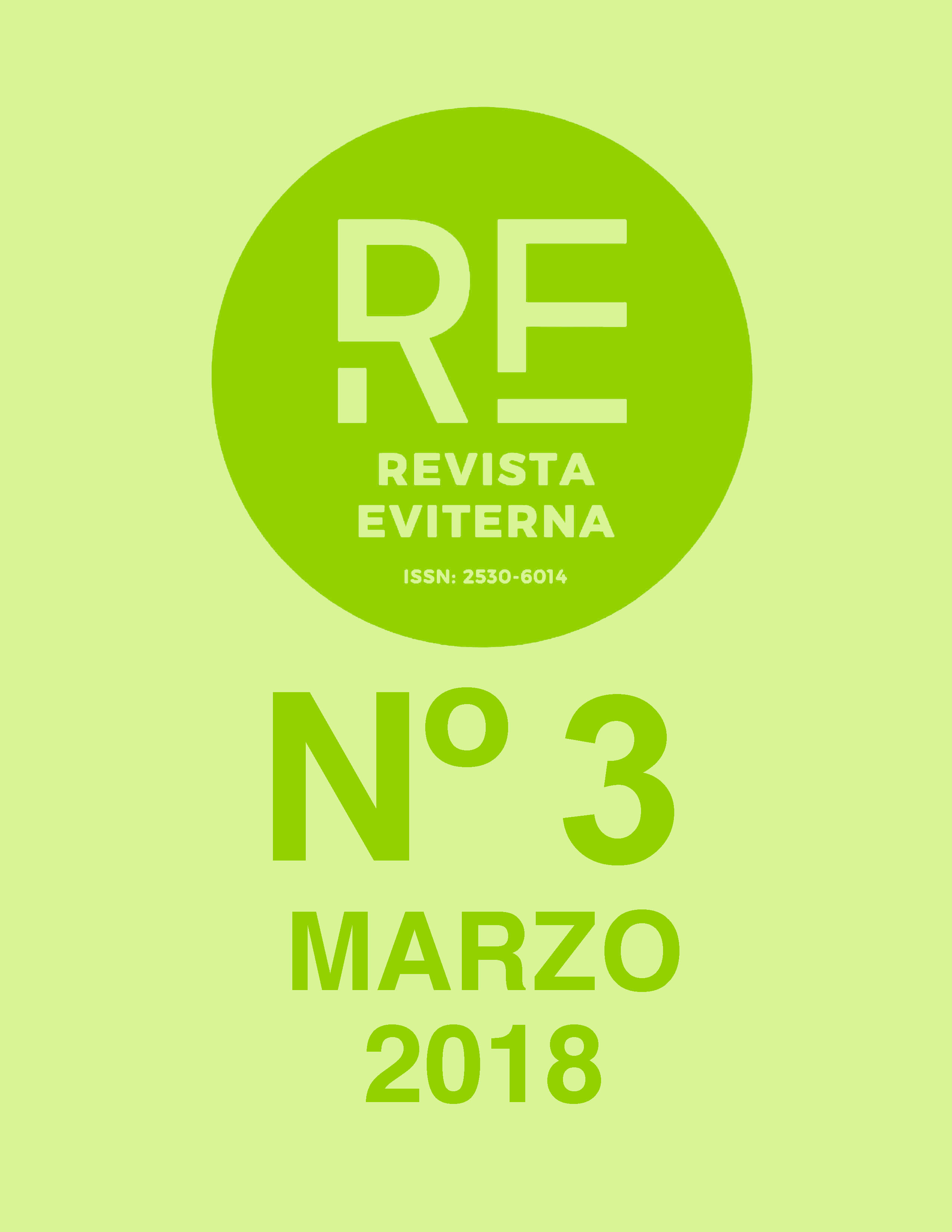Naturaleza, ciencia y mito en el arte del paisaje de Frederic Leighton
DOI:
https://doi.org/10.24310/Eviternare.v0i3.8163Palabras clave:
Frederic Leighton, Paisaje, Plein air pintura, Ciencia, Mitografía, Siglo XIXResumen
Frederic Leighton es principalmente reconocido como el presidente de la Royal Academy en la segunda mitad del siglo XIX, exhibiendo pinturas figurativas de gran escala con un alto grado de acabado. La beca, sin embargo, ha pasado por alto sus pinturas al aire libre creadas durante sus frecuentes viajes a Italia, España, Egipto y Grecia, por nombrar algunos. Como los bocetos al óleo de Leighton comprenden más de 200 lienzos y tablas, su importancia para su obra es primordial y debe ser claramente articulada. Usando el ejemplo de An Outcrop in the Campagna, este artículo explora cómo los tres aspectos - naturaleza, ciencia y mito - se fusionaron en la visión del paisaje de Leighton. Se examinan la composición y la técnica de la pintura, así como la influencia del círculo de Leighton, ejemplificado por Giovanni Costa y la Escuela de Arte Etrusco. Finalmente, la física solar y la termodinámica victorianas se presentan como un contexto importante para la dimensión simbólica de los paisajes de Leighton.
Descargas
Métricas
Publicación Facts
Perfil de revisores N/D
Información adicional autores
Indexado: {$indexList}
-
Indexado en
- Sociedad Académica/Grupo
- N/D
- Editora:
- Universidad de Málaga
Citas
BARRINGTON, Emilie (1906). The Life, Letters and Work of Frederic Leighton, 2 vols. London: George Allen.
BEER, Gilian (1989), “ ‘The Death of the Sun’: Victorian Solar Physics and Solar Myth”, in BULLEN, J. B. (ed.). The Sun is God: Painting, Literature and Mythology in the Nineteenth Century. Oxford: Oxford University Press, pp. 159-180.
BENSON, Donald R. (1987), ‘“Catching Light”: Physics and Art in Walter Pater’s Cultural Context’, in LEVINE, George (ed.). One Culture. Madison: University of Wisconsin Press, pp. 143-163.
BILLS, Mark and BRYANT, Barbara (2008). G. F. Watts: Victorian Visionary. New Haven and London: Yale University Press.
GALASSI, Peter (1991). Corot in Italy. New Haven and London: Yale University Press.
GOETHE, Johann Wolfgang (2000), “Goethe’s Theory of Colours”, in WEBER, A. S. (ed.). 19th Century Science: An Anthology. Ontario: Broadview Press.
HARRISON, Colin and NEWALL, Christopher (2010). The Pre-Raphaelites and Italy. Oxford: Ashmolean Museum.
HAMERTON, Philip Gilbert (1875), “Technical Notes on Lord Leighton”, Portfolio, pp. 31-32.
HOEPPE, Götz (2007). Why the Sky is Blue: Discovering the Color of Life. Princeton: Princeton University Press.
LANG, Mrs Andrew (1886). Sir Frederick Leighton, BART. London: Art Journal Office.
LEIGHTON, Frederic (1887), “Art in Modern Italy; Tuscany. The Renaissance” in LEIGHTON, Frederic. Addresses Delivered to the Students of the Royal Academy (1897). London: Kegan Paul, Trench, Trübner and Co., pp. 135-172.
LIGHTMAN, Bernard (1997), “ ‘The Voices of Nature’: Popularizing Victorian Science”, in LIGHTMAN, Bernard (ed.), Victorian Science in Context. Chicago: Chicago University Press, pp. 187-211.
NEWALL, Christopher (1989). The Etruscans: Painters of the Italian Landscape 1850-1900. Stoke-on-Trent: Stoke on Trent City Museum and Art Gallery.
ORMOND, Leonée and Richard (1975). Lord Leighton. New Haven and London: Yale University Press.
OUTRAM, Dorinda (2006). Panorama of the Enlightenment. Los Angeles: Getty Publications.
PAINTING FROM NATURE: The Tradition of Open-Air Oil Sketching from the 17th to 19th Centuries (1981). London: Arts Council of Great Britain.
REYNOLDS, Simon (1992), “William Blake Richmond in Italy”, Apollo, vol. 136, no. 367, pp. 161-165.
RIOPELLE, Christopher (1999), “52. An Outcrop in the Campagna, perhaps 1866”, in RIOPELLE, Christopher and BRAY, Xavier. A Brush with Nature: The Gere Collection of Landscape Oil Sketches. London, National Gallery Publications.
ROSSETTI AGRESTI, Olivia (1907). Giovanni Costa: His Life, Work, and Times. London: Gay and Bird, 1907.
RUSKIN, John (1869). The Queen of the Air: Being A Study of the Greek Myths of Cloud and Storm. London: Smith, Elder and Co.
RUSKIN, John (1884). The Storm-Cloud of the Nineteenth Century. Two Lectures Delivered at the London Institution. Kent: George Allen.
SCHMIDT, Arnika (2016). Nino Costa (1826-1903): Transnational Exchange in European Landscape Painting. Milan: Silvana Editoriale.
STAFFORD, Barbara Maria (1984). Voyage into Substance: Art, Science, Nature, and the Illustrated Travel Account, 1760-1840. Cambridge, Massachusettes and London: MIT Prress.
STALEY, Allen and NEWALL, Christopher (2004). Pre-Raphaelite Vision: Truth to Nature. London: Tate Publishing.
TYNDALL, John (1871). Fragmets of Science for Unscientific People: A Series of Detached Essays, Lectures, and Reviews. New York: D. Appleton and Company.
WEBER, A. S. (2010) (ed.). 19th Century Science: An Anthology. Ontario: Broadview Press.
YANNIS, Kanarakis (2010), “The Aesthete as a Scientist: Walter Pater and Nineteenth-Century Science”, Victorian Network, vol. 2, no. 1, pp. 88-105.
Descargas
Publicado
Cómo citar
Número
Sección
Licencia
Todos los contenidos publicados en Revista Eviterna están sujetos a la licencia Creative Commons Reconocimento-NoComercia-Compartirigual 4.0 cuyo texto completo puede consultar en <http://creativecommons.org/licenses/by-nc-sa/4.0>

Se pueden copiar, usar, difundir, transmitir y exponer públicamente, siempre que:
- Se cite la autoría y la fuente original de su publicación (revista, editorial y URL de la obra).
- No se usen para fines comerciales.
- Se mencione la existencia y especificaciones de esta licencia de uso.
Los derechos de autor son de dos clases: derechos morales y derechos patrimoniales. Los derechos morales son prerrogativas perpetuas, irrenunciables, intransferibles, inalienables, inembargables e imprescriptibles.
De acuerdo con la legislación de derechos de autor, Revista Eviterna reconoce y respeta el derecho moral de los autores/as, así como la titularidad del derecho patrimonial, el cual será cedido a la Universidad de Málaga para su difusión en acceso abierto.
Los derechos patrimoniales, se refieren a los beneficios que se obtienen por el uso o divulgación de las obras. Revista Eviterna se publica en open access y queda autorizada en exclusiva para realizar u autorizar por cualquier medio el uso, distribución, divulgación, reproducción, adaptación, traducción o transformación de la obra.
Es responsabilidad de los autores/as obtener los permisos necesarios de las imágenes que están sujetas a derechos de autor.







12.png)



